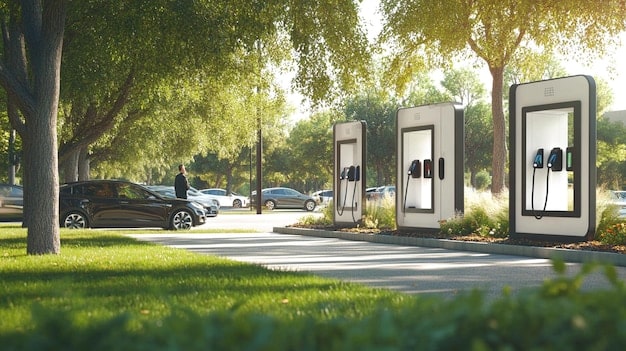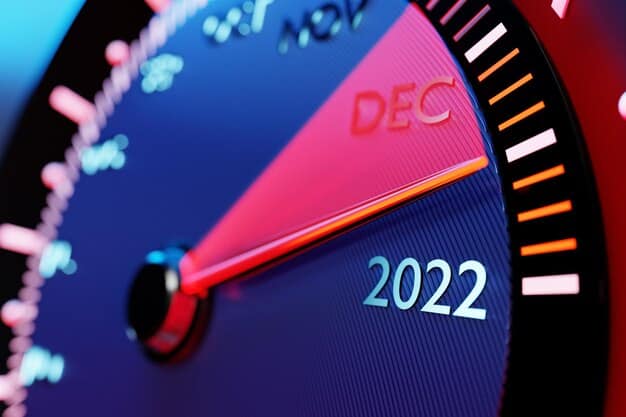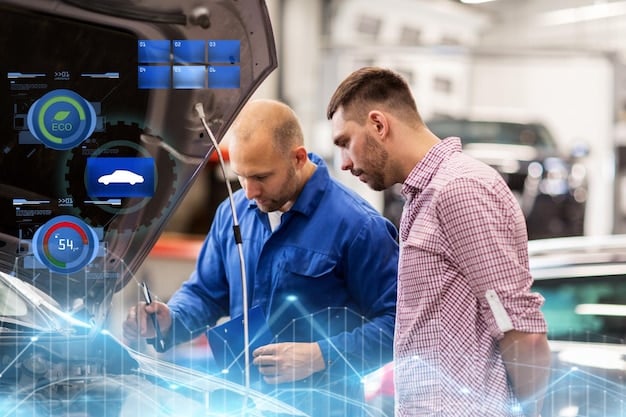Fuel Efficiency Standards 2025: Key Implications for Automakers

The key implications of the new federal fuel efficiency standards for automakers in 2025 include significant investments in electric vehicle (EV) technology, potential shifts in manufacturing strategies, and the need to adapt to evolving consumer preferences and regulatory landscapes to remain competitive.
Navigating the road ahead just got a little more complex for automakers. The new federal fuel efficiency standards for automakers in 2025 are set to reshape the industry, pushing manufacturers toward innovative solutions and strategic realignments.
Understanding the New Federal Fuel Efficiency Standards
The automotive industry in the United States is on the cusp of a major transformation, largely driven by the implementation of new federal fuel efficiency standards. These standards, slated to take full effect in 2025, represent a significant step towards reducing greenhouse gas emissions and promoting more sustainable transportation.
At their core, these standards mandate that automakers achieve a fleet-wide average fuel economy that is substantially higher than current levels. This means that the average miles per gallon (MPG) across all vehicles sold by a manufacturer must meet or exceed a specific target set by regulatory bodies. This target will steadily increase over the next several years, compelling automakers to innovate and adapt their product offerings.

The implications of these standards extend far beyond simply improving MPG. They are designed to encourage the development and adoption of alternative fuel technologies, such as electric vehicles (EVs) and hybrid vehicles. Automakers will need to invest heavily in these technologies to meet the rising fuel efficiency targets. Failure to comply with the standards can result in significant financial penalties, making adherence a critical priority for manufacturers.
The Rationale Behind the New Standards
The push for stricter fuel efficiency standards is rooted in concerns about climate change and energy security. Transportation is a major contributor to greenhouse gas emissions, and improving fuel economy is seen as a vital strategy for reducing the carbon footprint of the sector. By setting ambitious targets, the government aims to accelerate the transition to a cleaner, more sustainable transportation system.
Key Provisions of the Standards
- Increasing MPG Targets: Automakers must achieve progressively higher MPG averages for their fleets each year.
- Incentives for EVs and Hybrids: The standards provide credits and incentives for manufacturers that produce and sell electric and hybrid vehicles.
- Flexibility Mechanisms: Certain provisions allow automakers some flexibility in meeting the standards, such as trading credits with other manufacturers.
In conclusion, the new federal fuel efficiency standards represent a significant regulatory shift that will have far-reaching effects on the automotive industry. Automakers must proactively address these challenges by investing in new technologies and adapting their business models to thrive in a more sustainable transportation landscape.
Investment in Electric Vehicle Technology
One of the most significant implications of the new fuel efficiency standards is the impetus for automakers to heavily invest in electric vehicle (EV) technology. Meeting the stringent MPG requirements necessitates a substantial shift towards electrification, compelling manufacturers to allocate significant resources to research, development, and production of EVs.
This surge in investment is not merely a response to regulatory pressure; it also aligns with the growing consumer demand for EVs. As battery technology improves, and charging infrastructure expands, electric vehicles are becoming increasingly appealing to a wider range of drivers. Automakers recognize that a strong EV portfolio is crucial for long-term success in the evolving automotive market.
The Scale of Investment
The investment figures are staggering. Major automakers have announced multi-billion-dollar commitments to electrify their vehicle lineups. This includes building new battery factories, retooling existing assembly plants to produce EVs, and expanding research and development efforts to improve battery performance and reduce costs.

Impact on Manufacturing
The transition to EV production has a profound impact on manufacturing processes. Electric vehicles have fewer moving parts than internal combustion engine (ICE) vehicles, which simplifies assembly and reduces the need for certain types of components. This shift requires automakers to retrain their workforce and adapt their supply chains to accommodate the new manufacturing paradigm.
Challenges and Opportunities
- Supply Chain Disruptions: Securing a reliable supply of critical materials like lithium, cobalt, and nickel is essential for EV battery production.
- Charging Infrastructure: Expanding the availability of public charging stations is crucial for addressing range anxiety and encouraging EV adoption.
- Technological Innovation: Ongoing research and development are needed to improve battery energy density, charging speeds, and overall EV performance.
In conclusion, the push towards electric vehicle technology represents a fundamental shift in the automotive industry. While challenges remain, the opportunities for innovation and growth are immense. Automakers that embrace electrification and invest strategically in EV technology are poised to thrive in the years to come.
Shifts in Manufacturing Strategies
The new federal fuel efficiency standards are not only driving investment in EV technology but also prompting significant shifts in manufacturing strategies for automakers. To meet the rising MPG targets, manufacturers must re-evaluate their product portfolios, production processes, and supply chain relationships.
These shifts are multifaceted, encompassing everything from downsizing engine sizes and incorporating lightweight materials to optimizing vehicle aerodynamics and improving manufacturing efficiency. Automakers are exploring a range of strategies to reduce fuel consumption and emissions across their entire vehicle lineup.
Downsizing and Optimization
One common approach is to downsize engine sizes while employing turbocharging and other technologies to maintain performance. Smaller engines consume less fuel, and turbocharging provides the necessary power when needed. Automakers are also focusing on optimizing vehicle aerodynamics to reduce drag and improve fuel efficiency at higher speeds.
Lightweighting Strategies
Reducing vehicle weight is another critical strategy for improving MPG. Automakers are increasingly using lightweight materials such as aluminum, carbon fiber, and high-strength steel in their vehicle construction. These materials can significantly reduce weight without compromising safety or performance.
Supply Chain Adaptations
- Sourcing Sustainable Materials: Automakers are seeking more sustainable and ethically sourced materials for their vehicles.
- Localizing Production: Bringing production closer to key markets can reduce transportation costs and improve supply chain resilience.
- Collaborating with Suppliers: Strong partnerships with suppliers are essential for accessing innovative technologies and materials.
In conclusion, the new fuel efficiency standards are driving a wave of innovation and adaptation in automotive manufacturing. Automakers that can successfully navigate these challenges and implement effective manufacturing strategies will be well-positioned to succeed in the evolving automotive market.
Adapting to Evolving Consumer Preferences
Beyond the technological and manufacturing implications, the new fuel efficiency standards also necessitate that automakers adapt to evolving consumer preferences. As fuel economy becomes an increasingly important factor for car buyers, manufacturers must offer vehicles that meet both regulatory requirements and consumer demands.
This means striking a balance between fuel efficiency, performance, and features. Automakers must develop vehicles that are not only environmentally friendly but also appealing to a wide range of consumers. This requires a deep understanding of consumer preferences and the ability to anticipate future trends.
The Rise of Hybrid Vehicles
Hybrid vehicles are playing an increasingly important role in meeting fuel efficiency standards and appealing to consumers. Hybrids offer a balance between fuel economy and performance, making them an attractive option for drivers who are not yet ready to fully commit to electric vehicles.
SUVs and Fuel Efficiency
The continued popularity of SUVs presents a challenge for automakers seeking to improve fuel efficiency. SUVs are typically less fuel-efficient than smaller cars, so manufacturers must find ways to reduce their fuel consumption without compromising their functionality or appeal.
Marketing and Education
- Highlighting Fuel Efficiency: Automakers are emphasizing the fuel efficiency of their vehicles in their marketing campaigns.
- Educating Consumers: Providing consumers with clear and accurate information about fuel economy and emissions is essential.
- Offering Incentives: Automakers are offering incentives and rebates to encourage consumers to purchase fuel-efficient vehicles.
In conclusion, adapting to evolving consumer preferences is a critical aspect of meeting the new fuel efficiency standards. Automakers that can successfully align their product offerings with consumer demands will be well-positioned to thrive in the years ahead.
Navigating the Regulatory Landscape
The new federal fuel efficiency standards operate within a complex regulatory landscape, requiring automakers to understand and comply with a variety of rules and regulations. This includes not only the MPG targets themselves but also provisions related to emissions testing, credit trading, and reporting requirements.
Compliance with these regulations can be challenging, especially for smaller automakers with limited resources. Manufacturers must invest in the expertise and infrastructure needed to navigate the regulatory landscape effectively.
Compliance Costs
Meeting the new fuel efficiency standards requires significant investment, which can increase the cost of vehicle production. Automakers must carefully manage these costs to remain competitive in the market.
Credit Trading Programs
The regulatory framework allows automakers to trade credits with each other, providing some flexibility in meeting the MPG targets. Manufacturers that exceed the standards can earn credits and sell them to those that are struggling to comply.
Reporting Requirements
- Fuel Economy Testing: Automakers must conduct rigorous fuel economy testing to ensure that their vehicles meet the standards.
- Emissions Reporting: Manufacturers must report emissions data to regulatory agencies on a regular basis.
- Compliance Audits: Regulatory agencies conduct audits to verify that automakers are complying with the standards.
In conclusion, navigating the regulatory landscape is a critical aspect of meeting the new fuel efficiency standards. Automakers that can effectively manage compliance costs, participate in credit trading programs, and meet reporting requirements will be well-positioned to succeed in the evolving automotive market.
Potential Economic Impacts
The implementation of the new federal fuel efficiency standards has the potential to create both positive and negative economic impacts. On the one hand, the standards can stimulate innovation, create jobs in the clean energy sector, and reduce reliance on foreign oil. On the other hand, they can increase vehicle costs, potentially reduce sales, and lead to job losses in traditional automotive manufacturing.
The overall economic impact will depend on a variety of factors, including the pace of technological innovation, the level of consumer acceptance of EVs, and the government’s policy response to any potential negative consequences.
Job Creation
The transition to electric vehicle production has the potential to create new jobs in areas such as battery manufacturing, charging infrastructure development, and software engineering.
Impact on Consumers
The new fuel efficiency standards could lead to higher vehicle prices, at least in the short term. However, consumers may also benefit from lower fuel costs and reduced maintenance expenses over the long term.
Impact on the Auto Industry
- Increased Investment: Automakers will need to invest heavily in new technologies and manufacturing processes.
- Market Share Shifts: Companies that are successful in developing and marketing fuel-efficient vehicles could gain market share.
- Supply Chain Disruptions: The industry could face disruptions in the supply of critical materials and components.
In conclusion, the new fuel efficiency standards have the potential to create significant economic impacts, both positive and negative. Policymakers, automakers, and consumers must work together to navigate these challenges and maximize the benefits of a more sustainable transportation system.
| Key Point | Brief Description |
|---|---|
| ⚡ EV Investments | Automakers are heavily investing in electric vehicle technology to meet new standards. |
| ⚙️ Manufacturing Shifts | Significant changes in manufacturing strategies are underway, including lightweighting and engine downsizing. |
| 💲 Economic Impacts | Job creation and potential cost increases for consumers are anticipated. |
| 📊 Regulatory Compliance | Navigating complex regulations is crucial for automakers to avoid penalties. |
Frequently Asked Questions
▼
The primary goals are to reduce greenhouse gas emissions, promote sustainable transportation, and improve energy security by increasing the average fuel economy of vehicles sold in the US.
▼
Initially, the cost of new cars may increase due to investments in new technology and manufacturing processes. However, long-term savings on fuel and maintenance could offset this.
▼
Automakers that fail to comply with the standards may face significant financial penalties. They may also need to purchase credits from other manufacturers that exceed the standards.
▼
Yes, both government and automakers may offer incentives such as tax credits, rebates, and discounts to encourage consumers to purchase more fuel-efficient vehicles, including EVs and hybrids.
▼
The new standards are expected to shift the market towards more fuel-efficient models, including smaller cars, hybrids, and electric vehicles. Automakers will likely reduce the production of less fuel-efficient vehicles.
Conclusion
The new federal fuel efficiency standards for 2025 are set to bring about significant transformation in the automotive industry. Automakers must navigate a complex landscape of technological innovation, manufacturing shifts, evolving consumer preferences, and regulatory compliance. While challenges remain, the long-term benefits of a more sustainable transportation system are undeniable, paving the way for a cleaner, more efficient, and economically viable future.





